Genre: Shoot-‘Em-Up Developer: Konami Publisher: Konami Players: 1-2 Released: 1995
When I grew up in Germany in the 1990s, we didn’t have arcades per sé. If you were lucky, you would run into one or two arcade machines set up in public houses or indoor swimming pools. So, during my elementary and most of my high school days, the only places where I ever ran into arcade machines where located at a rather dingy eatery in the village I lived in or at the the tiny natatorium next town over where our school sent us for the swimming parts of our physical education classes. Naturally, what with both being comparably ratty establishments somewhere in Backwater Bavaria, they hardly ever ran the newest titles available. Whatever games they had had to have the broadest mass appeal and speak to a wide range of potential audience without offending anyone, so they just ran Tetris, Bubble Bobble, and the original Wonder Boy for ages. Imagine my surprise then, when one day one of the two available cabinets at the public swimming pool didn’t display the usual cutesy bubble-spewing dragons but an entirely different, yet still rather cutesy looking kind of game. Now, my friends and I had already played some shmups before – most of us had either a home computer or consoles back home – but we had never seen such a weird-looking game where you steered an octopus through space, shooting at penguins, Moai heads, pigs or cat-headed pirate ships. I didn’t play it too much – I needed to save what spare pocket money I had for more Genesis/Mega Drive games, after all – but the colorful graphics and the absurdity of the setting, which was completely unlike the other usually quite dark and gritty shmups out there, definitely left an impression on me.
Fast forward four or five years. I had managed to scrounge up enough money to afford a Sega Saturn along with one single game, which didn’t last me long. Since I didn’t have the money to spare to get more games right away, rentals were the way to go, so I checked out my regular video game rental place to see what he could fix me up with. Imagine my surprise when among the few releases available, one of them would bear the title of the very same arcade game that drew me in after my monthly swimming classes all those years ago: Parodius! Only, it wasn’t just that. While in PAL regions the Saturn game was just plain and simply called Parodius, it was actually the localized version of the Japanese release called the Gokujō Parodius Da! Deluxe Pack, a single-disc bundle of the first arcade release (also known as Parodius Da! ~Shinwa kara Owarai e~ or Parodius: From Myth to Laughter, in allusion to the tagline of Gradius III: From Myth to Legend) along with its sequel Parodius: Fantastic Journey. It would be ages before I learned that we Europeans were lucky to receive that game at all. Sadly, Saturn owners in the U.S. would never see even a single Parodius game released on the platform in their region, which is too bad because they really missed out on a great early release that, unlike many other fifth generation console games, holds up remarkably well even today.
For those who have never heard of the game before, Parodius started out as a parody of Konami’s Gradius series of shoot-’em-ups (hence the name: Parody+Gradius=Parodius). While the first game in the series was technically released on the MSX computer platforms and exclusively in Japan, the series really gained popularity when it hit arcades in 1990 with the first Parodius. While the gameplay will feel very familiar to anyone who has ever played a shoot-’em-up before, particularly any one of the Gradius series, what sets the game apart from other shmups of its era are the bright, comical colors as well as the unusual enemy types and stage dressings. The first arcade game has four selectable characters, one of which is actually the iconic Vic Viper from the original Gradius (even sporting its original weapon scene). Tako the Octopus, an original character who has basically become the mascot of the series, has a weapon layout which should be familiar to fans of the Gradius spinoff Salamander. Pentarou the Penguin has his roots in the 1983 arcade game Arctic Adventure and sports the Gradius III configuration. Finally, there’s Twinbee, on loan from the eponymous vertical comic shooter series of Konami’s. The sequel throws in even more characters, most of which owning their own particular version of some Gradius weapon configuration. Power-ups are handled in a similar fashion to the Gradius games, with a spot of Twinbee thrown in for good measure. Certain enemies leave an orange power that when collected fills up a six-stage power-up bar on the bottom of the screen. The first power-up is always more speed for your chosen fighter, and after that the upgrades are dependent on the individual weapon configuration. When playing Parodius, you can choose whether you want the status bar to upgrade steadily in an automatic fashion or whether you’d like to choose your upgrades manually from a “Roulette”-style menu. Fantastic Journey offers a third, semi-automatic option limiting the manual selection of upgrades only to a few select choices. Additionally, some enemies release bells into the stage, which sport a separate line of upgrades depending on the color of the bell selected. Yellow are just bonus points, green scales up your sprite and turns your fighter invincible for a short period, others fire a barrier that keeps out enemy shots, and so on.
Similarly to Gradius, each level has a short introductory stage set in space that allows players to easily rack up upgrades in preparation for things to come. The gameplay is very smooth, and the enemy types not only come in a great variety, but the comic style also gives them lots of personality. However, while the games may not be quite as tough as the Gradius series, they still bear the DNA of their arcade roots. The first two stages of both games are relatively smooth sailing, but after that the difficulty ramps up and demands a lot of dodging and weaving between obstacles from players, as well as learning enemy patterns to avoid and learning stage layouts by heart. The games still sport one hit kills, so one mistake will knock you out if you don’t have a fully upgraded fighter with a shield, and even that doesn’t last for many hits. You do not have to restart a level right from the start, but if you lose a life you also lose all of your upgrades, which makes all further progress much harder.
However, for a shmup of this type, the game is very generous with its upgrades. The options menu of allows you to select a generously wide range of difficulty settings, hitboxes for your fighter (small, normal or large) as well as the number of lives, and you get unlimited continues. This helps out beginners or players not familiar with the shmup genre quite a bit. The first arcade game still has quite a few unfair difficulty spikes no matter what difficulty you choose though, which can only be overcome by patiently learning certain layouts and patterns by heart. The balancing, along with it having more stages and a greater array of selectable fighters, makes Fantastic Journey the better game of the two by a long shot, even if it’s also quite a bit easier on average. What’s also great is that you don’t have to play that game by yourself. The Saturn version of Fantastic Journey has a simultaneous two-player-mode, so you can have a friend join in on the fray.
The gameplay is also very smooth. Both games are ported directly from the arcade, but each sports a hidden extra stage. Aside from a few very bearable load times due to the CD format, the game moves along at a steady pace, and unlike its PlayStation counterpart, hardly suffers from slowdown. Only the final hidden stage, which plays after the end credits after certain conditions have been fulfilled, can slow down to a crawl due hardware struggling with the bullet-hell nature the game takes on for this extra tough challenge.
It’s the levels themselves that the Parodius games really make shine, especially the enemy types contained therein. The first arcade game generously lifts its stage layouts and boss patterns from the first three games in the Gradius series (as well as Salamander), but you would only know that if you knew the latter by heart. It’s the dressing that makes all the difference, filled with peculiar characters. The first stage resembled a beach side and sports, among other things, a flying battleship with an animated cat as a figurehead and a penguin dressed as a pirate for a boss. The cat battleship makes a return in Fantastic Journey as well, this time as a submarine and wearing an appropriate snorkel mask. Other stages are set in a gaudy Las Vegas-style resort, a discotheque, a Night of the Living Dead-like graveyard, or a cake factory. The Moai heads that have become a staple in many different arcade shooters make an appearance as well, but they are more laid back, wearing sunglasses or earrings and giving off a very chill vibe. You fight giant cartoon octopuses, panda bears in ballerina outfits or moon bunnies, along with lots and lots of penguins, some of which are also doing a lot of crazy things in the stage backgrounds. The soundtrack also fits into the cute and comic style and contains a few swing passages, but mostly jaunty folk tunes or a few classic tracks one might be familiar with, like the “Can-Can” or the “Waltz of the Flowers” from the Nutcracker Suite.
Parodius was very popular in Europe, both in arcades as well as the home releases, and as far as I know the series was also quite celebrated in its native Japan. Why was the series never brought stateside? Well, there may be two reasons that come to mind in regard to this Saturn version, which aside from the hidden bonus stages is basically a straight port of the arcade games. The first concerns one specific character: The boss of the second, Las Vegas-themed stage in Parodius is “Eagle Sabnosuke,” a cartoonish American bald Eagle complete with Uncle Sam hat (also a parody of the Phoenix boss in Gradius II, with similar attack patterns) and who returns as a minor enemy throughout Fantastic Journey as well. Rumor has it that a character with such patriotic trimmings as an enemy type might have caused too much controversy in the US; even for the PAL release they decided to give the Eagle sprite a recolor so that he looks more like green parrot, and they removed the star-spangled banner from the character’s headband.
However, while that issue could easily be fixed with a sprite swap, I assume the more likely reason why the Parodius games were never really brought stateside lies in sort of humor inherent to the games. While usually on the silly side, the Parodius titles can get quite raunchy from as well. The Octopus protagonist of Parodius wears a set of panties on his head, Fantastic Journey has a playboy bunny straddling a rather phallic-looking rocket as a playable character, another character wears a condom in front of his spaceship for “protection” in lieu of a shield, and a rather iconic recurring boss character in both games is is a scantily clad go-go dancer who the player – in another parody of a boss from Gradius II – has to avoid by flying between her legs while she suggestively sways her hips. Stages take place in bath houses, boss enemies include a giant, well-endowed mermaid, and so on. And those are just the things I can list from the top of my head. While Parodius itself is relatively harmless in that regard (though it was the game that had the first appearance of Chichibinta Rika), the series steadily ramped up the suggestiveness in Fantastic Journey. Still, if you’re not prudish towards these things, these things are fun and quite harmless. The final game in the series, Sexy Parodius, meanwhile… well, it doesn’t have the name for no reason, let’s put it that way.
Both Parodius and Fantastic Journey are quite short. Experienced shmup veterans might finish then in about 30 to 45 minutes each, but the journey is very fun and quite enjoyable even for gamers who aren’t fans of the shoot-’em-up genre. It’s full of loving parodies, cute graphics, and silly humor that still manage to entertain. The Saturn port is pretty much spot-on and plays to the 2D strengths of the platform. Plus, the comical graphics have held up beautifully over the years. The game may not be laugh-out funny, but you’ll have a hard time playing it without cracking a smile.
SCORE: 8 out of 10

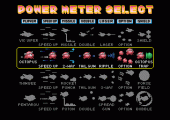
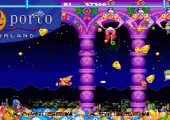
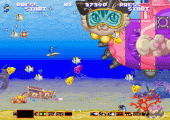
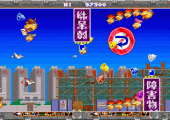
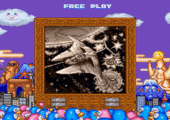
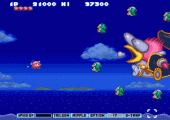
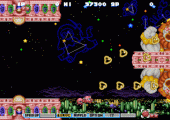
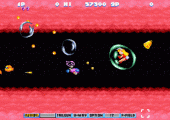
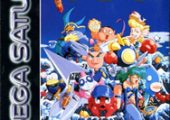
Recent Comments